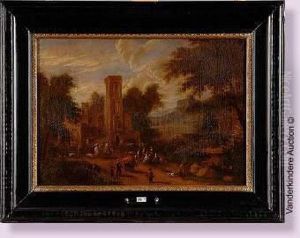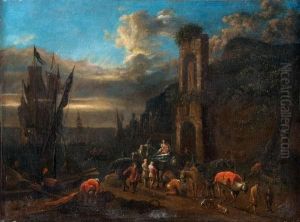Mathieu Schoevaerdts Paintings
Mathieu Schoevaerdts was a Flemish painter born in 1663, whose work primarily focused on landscapes, cityscapes, and architectural paintings. While not as widely recognized as some of his contemporaries, Schoevaerdts made significant contributions to the genre of landscape painting in the late 17th century. His exact place of birth remains unclear, but he was active in the art scene of Brussels, which was a vibrant center for artistic production during this period.
Schoevaerdts’ works are characterized by their meticulous attention to detail, vibrant color palette, and the lively depiction of figures within natural and urban environments. He was known for his ability to blend architectural elements with natural landscapes, creating scenes that were both realistic and idyllic. His paintings often featured bustling marketplaces, serene riverbanks, and detailed renditions of city streets, filled with people going about their daily lives. This ability to capture the essence of daily life, while also highlighting the beauty of the landscape, set his work apart from that of his peers.
Despite his talent and the quality of his work, Mathieu Schoevaerdts did not achieve widespread fame during his lifetime, and details about his life are scarce. His career was relatively short, as he is believed to have died around 1694, when he was approximately 31 years old. The circumstances of his death are not well-documented, adding to the mystery surrounding his life and work.
The legacy of Mathieu Schoevaerdts lies in the influence his paintings had on the development of landscape and cityscape painting in the Flemish region. His works are held in various collections and museums, where they continue to be studied and appreciated for their contribution to the genre. Although not a household name, Schoevaerdts’ ability to capture the interplay between human activity and the natural world remains a testament to his skill as an artist.

